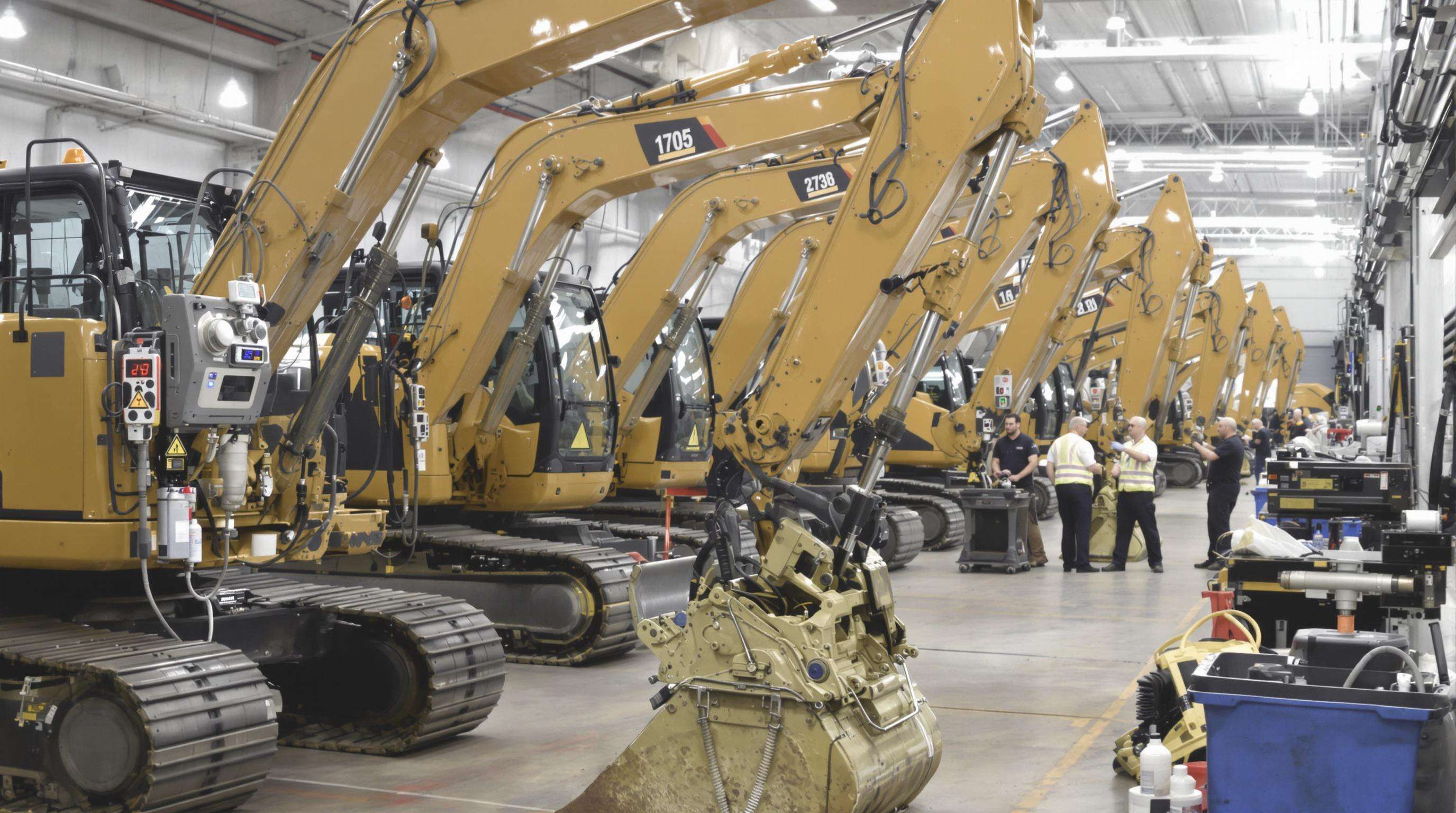How Should Excavators Be Properly Maintained?
Understanding Excavator Maintenance: Definition and Importance
What Is Excavator Maintenance and Why It Matters
Keeping excavators running right means regular checks, proper greasing, and swapping out worn parts when needed. Small problems such as hydraulic fluid leaks or tracks that aren't aligned correctly can turn into big headaches if ignored. Studies show that machines getting proper care face around 35 percent fewer unexpected breakdowns, which really helps keep projects on schedule. The good news is that sticking to a maintenance routine adds about 30 years to the life of these heavy-duty machines. For construction companies, this translates to better ROI on their equipment investments while maintaining consistent productivity across multiple job sites.
The Economic Impact of Poor Maintenance Practices
When regular maintenance gets ignored, it creates all sorts of money problems down the road. Machines that don't get their scheduled checkups tend to cost around 42 percent more for repairs throughout the year because parts like pumps and valves wear out faster than they should. Mid-sized construction companies are really feeling the pinch here too. We're talking about upwards of fifteen thousand dollars wasted on each excavator annually just from poor maintenance practices. And then there's the whole project timeline issue. Equipment breakdowns hold things back significantly. Contractors have told us that when machines start acting up, entire job sites slow down by about 18 percent while waiting for fixes or replacements.
Safety and Compliance in Excavator Operations
According to OSHA incident reports, 23% of equipment-related construction site accidents stem from poorly maintained excavators. Worn bucket teeth or degraded hydraulic hoses increase the risk of structural failure and injury. Regular maintenance ensures compliance with ISO 9249 safety standards, helping avoid fines of up to $7,000 per violation while safeguarding workers.
Daily and Weekly Maintenance Routines for Optimal Performance

Essential Daily Checks: Fluid Levels, Leaks, and Noises
Start each shift by checking hydraulic fluid, engine oil, and coolant levels against manufacturer specifications. Listen for unusual engine or pump noises that may indicate air intake problems or bearing wear. Inspect hoses for leaks—early detection prevents minor drips from turning into major hydraulic failures.
Inspecting Tracks, Bucket, and Attachments for Damage
Examine track links for cracks and undercarriage rollers for uneven wear. Check bucket teeth for fractures and confirm hydraulic couplers on attachments engage securely. Loose or damaged components contribute to 18% of excavation-related accidents, according to the Heavy Equipment Safety Council (2023).
Weekly Undercarriage Care and Lubrication Points
Remove built-up debris from track chains and rollers using plastic scrapers to prevent metal-to-metal contact. Lubricate all pivot joints with lithium-complex grease, focusing on boom and stick articulation points where friction causes wear three times faster than on stationary parts.
Track Tension Adjustment and Debris Removal Best Practices
Adjust track sag to 1–1.5 inches per manufacturer guidelines to minimize sprocket wear. Clear rocks and vegetation from track links using compressed air instead of metal tools. Improper cleaning methods increase undercarriage repair costs by 34% over a year, as reported in Construction Machinery Digest (2024).
Engine and Hydraulic System Maintenance for Excavators
Engine Oil, Coolant, and Filter Management Best Practices
Daily checks of engine oil viscosity and coolant quality prevent 63% of premature engine failures, according to Heavy Equipment Journal (2024). Always use manufacturer-specified fluids—incorrect coolant mixtures are responsible for 38% of overheating incidents. Replace air and fuel filters every 500 operating hours; clogged filters can reduce fuel efficiency by up to 17%.
Monitoring Belt Tension and Cooling System Efficiency
Improper belt tension causes 29% of hydraulic pump alignment issues. Test belts weekly with a deflection gauge—0.3 to 0.5 inches under 10 lbs of pressure indicates correct tension. Clean radiator fins monthly; blocked airflow raises coolant temperatures by an average of 22°F.
Hydraulic Fluid Changes and Leak Detection Techniques
Replace hydraulic fluid every 1,000 hours using viscosity-matched products. Inspect hoses during warm-up, when peak pressure reveals weak points—75% of leaks occur at coupling interfaces. Conduct quarterly infrared thermography scans to detect internal leaks before pressure loss becomes noticeable.
Troubleshooting Common Hydraulic System Issues
Erratic boom movement typically results from air in the system (45% of cases) or contaminated valves (31%). Bleed the system immediately if foaming appears in the reservoir. For sluggish bucket response, inspect pump suction lines first—68% of flow issues stem from inlet restrictions, not pump failure.
Long-Term Preventive Maintenance Planning by Operational Hours

Developing a Service Schedule Based on Usage (1,000 & 2,000 Hours)
Align maintenance with actual operating hours rather than calendar dates for greater precision. A usage-based schedule ensures timely servicing of critical components:
| 1,000-Hour Service | 2,000-Hour Service |
|---|---|
| Engine oil/filter replacement | Hydraulic pump pressure testing |
| Air filter inspection | Swing bearing lubrication |
| Track adjustment | Valve bank performance evaluation |
| Grease all pivot points | Final drive oil change |
This data-driven approach reduces unplanned downtime by 19% compared to fixed monthly schedules, as noted in Industry Equipment Journal (2023). Use digital hour loggers to automate maintenance alerts.
Major Component Inspection: Pumps, Valves, and Cylinders
At each service milestone, inspect hydraulic pumps for pressure deviations beyond OEM tolerances, check valve spools for scoring, and test cylinder rods for bending or pitting. Addressing early signs of wear prevents 63% of failures caused by progressive degradation.
Extending Excavator Lifespan Through Predictive Maintenance
Incorporate oil analysis and telematics to anticipate component wear. Monitoring iron particles in hydraulic fluid helps detect pump wear early, while tracking engine temperature trends reveals cooling inefficiencies. Operators using predictive techniques report 28% longer service life for key subsystems.
FAQ
What is the significance of regular excavator maintenance?
Regular maintenance is essential as it minimizes unexpected breakdowns, extends the excavator's lifespan, and maintains productivity. Proper care results in fewer repairs and leads to better returns on investments.
How does poor maintenance affect construction companies financially?
Poor maintenance practices increase repair costs by around 42% annually and can lead to significant project delays. It may cost construction companies approximately fifteen thousand dollars per excavator each year due to neglect.
What safety measures should be included in excavator maintenance?
Regular maintenance ensures compliance with ISO 9249 safety standards, which helps avoid costly fines while ensuring worker safety. Inspecting and replacing worn parts is crucial to prevent accidents.
How often should hydraulic fluid be changed?
Hydraulic fluid should be replaced every 1,000 operating hours to ensure optimal performance. Regular inspection for leaks during fluid changes is also advised.
What is a usage-based service schedule?
A usage-based service schedule aligns maintenance activities with actual operating hours instead of fixed calendar dates. This ensures precise timing for servicing critical excavator components.

